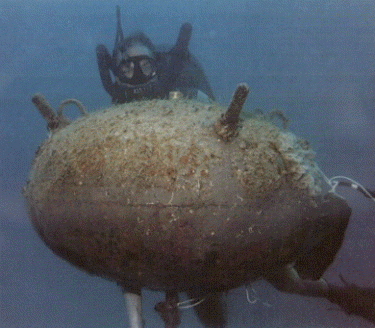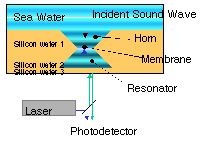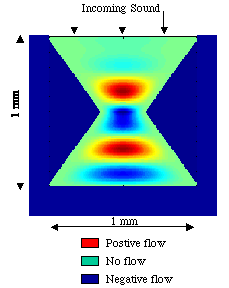Thomas G. Bifano, tgb@bu.edu
Robin O. Cleveland, Debora A. Compton, Allan D. Pierce>
Department of Aerospace and Mechanical Engineering, Boston University
110 Cummington St., Boston, MA 02115
Popular version of paper 2aEA5
Presented Tuesday morning, March 16th, 1999
ASA/EAA/DAGA '99 Meeting, Berlin, Germany
 A significant problem for the
Navy is the presence of mines in littoral waters, that is,
close to the shore and in the surf zone, in particular. The figure to the right
shows a Navy SEAL diver placing a detonator on an Iraqi mine. The
action of the surf means that a large amount of silt and bubbles are
suspended in the water which reduces optical visibility to about 1 meter.
Currently, mines in the surf zone are detected by deploying divers to
visually identify the mines. However, the lack of visibility means that
the divers often find objects by swimming into them. This obviously has
severe consequences if the object is a mine. The Navy is developing an
acoustic based system to provide divers with a clearer image underwater.
Sound has the potential to "see" further through silty and bubbly water
than does light. What is sought is a device that works like bat sonar;
that is, it sends out an acoustic ping into the water and from the echoes
it can reconstruct a visual image. The echoes would be collected on an
array of acoustic sensors in the same way that the human eye collects light
on an array of light-sensitive cells.
A significant problem for the
Navy is the presence of mines in littoral waters, that is,
close to the shore and in the surf zone, in particular. The figure to the right
shows a Navy SEAL diver placing a detonator on an Iraqi mine. The
action of the surf means that a large amount of silt and bubbles are
suspended in the water which reduces optical visibility to about 1 meter.
Currently, mines in the surf zone are detected by deploying divers to
visually identify the mines. However, the lack of visibility means that
the divers often find objects by swimming into them. This obviously has
severe consequences if the object is a mine. The Navy is developing an
acoustic based system to provide divers with a clearer image underwater.
Sound has the potential to "see" further through silty and bubbly water
than does light. What is sought is a device that works like bat sonar;
that is, it sends out an acoustic ping into the water and from the echoes
it can reconstruct a visual image. The echoes would be collected on an
array of acoustic sensors in the same way that the human eye collects light
on an array of light-sensitive cells.
Fabrication of the receiver array is particularly challenging because it should consist of over 10,000 independent acoustic sensors. Although arrays of this size are commonly found on ships, this device needs to be small enough that it can be either hand-held (with perhaps a small video screen) or head-mounted, with the images displayed in special goggles. The same technology that is used to fabricate silicon chips for computers can also be used to build mechanical devices on a silicon chip. In addition, it is possible to place both mechanical devices and electrical circuits on the same chip; this technology is refered to as MicroElectroMechanical Systems (MEMS). Among the great variety of successfully developed MEMS are pressure sensors and accelerometers, the latter of which are now used universally in automotive air-bag deployment systems.
In this work we report on a MEMS-based design of a new type of underwater acoustic receiver (also referred to as a hydrophone). Most hydrophones are made from a piezo-electric crystal. This is a special material which generates a small voltage when a sound wave squeezes it. In contrast the heart of our system is a very small membrane, carved into a solid piece of silicon, which can vibrate with a sound wave. By bouncing a laser beam off of the membrane it is possible to measure the sound. It is possible to place thousands of small membranes onto a single silicon chip. It should be possible to fabricate the entire receiver, the hydrophone array and the electronics, onto a single silicon chip; which makes the underwater-sonar system realizable.
A possible weakness of using a membrane as a sensor is that the sound waves will move the membrane very slightly. Typical displacements from a sound wave are on the order of one angstrom (0.1 nanometers); the size of an atom! Although the human ear can detect these signals it is often hard to detect them with a mechanical device. We have incorporated into our MEMS device two substructures which can be formed in a silicon chip and lead to amplification of the displacement of the membrane. The first substructure is a "horn". It is similar to a hearing trumpet that people who were hard of hearing would use before the advent of electrical hearing aids. As the sound propagates down a horn from the mouth (large end) to the throat (narrow end) the motion of the sound is amplified. If the membrane is placed across the throat it will therefore under go more motion than if there was no horn at all. The second substructure is what is referred to as a Helmholtz or acoustic "resonator". A common example of an acoustic resonator is a beer bottle which produces a tone when you blow across the neck. The small excitation is amplified by the bottle to produce a loud tone and correspondingly large displacements of air at the opening of the bottle.
 Our device, the BU MEMS Hydrophone (shown
in the figure to the right), takes advantage of both the horn and
resonator. It consists of an hourglass cavity (a double frustum: a frustum
is a pyramid with its top cut off) carved into a solid piece of silicon.
The sound enters from the top. The upper frustum acts as a horn. The
lower frustum acts as a resonator. The membrane is placed at the neck of
both devices where the maximum displacement should occur. A laser beam is
fired through a small hole in the bottom so that the displacement of the
membrane can be detected. The whole device is less than 1 mm thick.
Preliminary experiments using a square membrane, 2 m thick and 300 m
across, excited by a pulse of 1 MHz ultrasound in water indicate that the
membrane moves in correspondence with the sound wave. When the membrane is
placed at the neck (narrow end) of a horn the displacement was amplified by
a factor of six.
Our device, the BU MEMS Hydrophone (shown
in the figure to the right), takes advantage of both the horn and
resonator. It consists of an hourglass cavity (a double frustum: a frustum
is a pyramid with its top cut off) carved into a solid piece of silicon.
The sound enters from the top. The upper frustum acts as a horn. The
lower frustum acts as a resonator. The membrane is placed at the neck of
both devices where the maximum displacement should occur. A laser beam is
fired through a small hole in the bottom so that the displacement of the
membrane can be detected. The whole device is less than 1 mm thick.
Preliminary experiments using a square membrane, 2 m thick and 300 m
across, excited by a pulse of 1 MHz ultrasound in water indicate that the
membrane moves in correspondence with the sound wave. When the membrane is
placed at the neck (narrow end) of a horn the displacement was amplified by
a factor of six.
 A mathematical model of the
sound field within the horn has been developed. The figure to the left
shows the predicted velocity field within the hourglass cavity. The model
allows us to predict the membrane motion due to an incident sound wave. It
can be used to determine the performance of a device for different size and
shape of the horn and resonator. These results will guide us in the design
of the structures that will be etched into the silicon.
A mathematical model of the
sound field within the horn has been developed. The figure to the left
shows the predicted velocity field within the hourglass cavity. The model
allows us to predict the membrane motion due to an incident sound wave. It
can be used to determine the performance of a device for different size and
shape of the horn and resonator. These results will guide us in the design
of the structures that will be etched into the silicon.
The development of this device will allow divers to be observe objects in
underwater environments; objects that would be otherwise be impossible to detect.
The technology is also capable of measuring airborne sounds and because of
the fiber-optic sensing system it would be immune to the presence of
electrical noise.